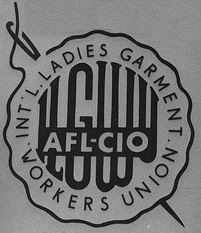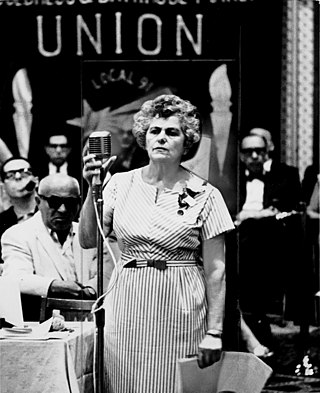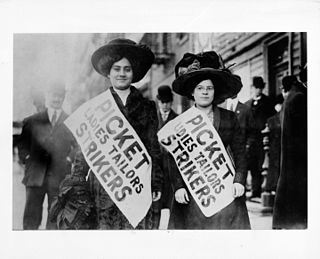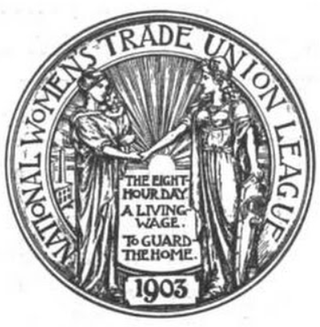
The Triangle Shirtwaist Factory fire in the Greenwich Village neighborhood of Manhattan, New York City, on Saturday, March 25, 1911, was the deadliest industrial disaster in the history of the city, and one of the deadliest in U.S. history. The fire caused the deaths of 146 garment workers—123 women and girls and 23 men—who died from the fire, smoke inhalation, falling, or jumping to their deaths. Most of the victims were recent Italian or Jewish immigrant women and girls aged 14 to 23; of the victims whose ages are known, the oldest victim was 43-year-old Providenza Panno and the youngest were 14-year-olds Kate Leone and Rosaria "Sara" Maltese.

The International Ladies' Garment Workers' Union (ILGWU), whose members were employed in the women's clothing industry, was once one of the largest labor unions in the United States, one of the first US unions to have a primarily female membership, and a key player in the labor history of the 1920s and 1930s. The union, generally referred to as the "ILGWU" or the "ILG", merged with the Amalgamated Clothing and Textile Workers Union in the 1990s to form the Union of Needletrades, Industrial and Textile Employees (UNITE). UNITE merged with the Hotel Employees and Restaurant Employees Union (HERE) in 2004 to create a new union known as UNITE HERE. The two unions that formed UNITE in 1995 represented 250,000 workers between them, down from the ILGWU's peak membership of 450,000 in 1969.

The Women's Trade Union League (WTUL) (1903–1950) was a U.S. organization of both working class and more well-off women to support the efforts of women to organize labor unions and to eliminate sweatshop conditions. The WTUL played an important role in supporting the massive strikes in the first two decades of the twentieth century that established the International Ladies' Garment Workers' Union and Amalgamated Clothing Workers of America and in campaigning for women's suffrage among men and women workers.

The Garment District, also known as the Garment Center, the Fashion District, or the Fashion Center, is a neighborhood located in the borough of Manhattan in New York City. Historically known for its role in the production and manufacturing of clothing, the neighborhood derives its name from its dense concentration of fashion-related uses. The neighborhood, less than 1 square mile, is generally considered to lie between Fifth Avenue and Ninth Avenue, from 34th to 42nd Streets.
Dorothy Jacobs Bellanca was an American labor activist who particularly represented women workers in the garment industry. She moved to the United states and started her first job as a hand buttonhole sewer, and later started organizing groups of her own. She was a strong leader and this led her to being a successful full time female organizer. She was leader and an activist that worked for many different causes.

Clara Lemlich Shavelson was a leader of the Uprising of 20,000, the massive strike of shirtwaist workers in New York's garment industry in 1909, where she spoke in Yiddish and called for action. Later blacklisted from the industry for her labor union work, she became a member of the Communist Party USA and a consumer activist. In her last years as a nursing home resident she helped to organize the staff.

Rose Pesotta (1896–1965) was an anarchist, feminist labor organizer and vice president within the International Ladies' Garment Workers' Union.

The New York shirtwaist strike of 1909, also known as the Uprising of the 20,000, was a labour strike primarily involving Jewish women working in New York shirtwaist factories. It was the largest strike by female American workers up to that date. Led by Clara Lemlich and the International Ladies' Garment Workers' Union, and supported by the National Women's Trade Union League of America (NWTUL), the strike began in November 1909.

Pauline M. Newman was an American labor activist. She is best remembered as the first female general organizer of the International Ladies Garment Workers Union (ILGWU) and for six decades of work as the education director of the ILGWU Health Center.
Benjamin "Ben" Schlesinger was a Lithuanian-born American trade union official and newspaper office manager. Schlesinger is best remembered as the nine-time president of the International Ladies Garment Workers Union (ILGWU), serving from 1903 to 1907, again from 1914 to 1923, and finally from 1928 until his death in 1932. He was also the managing editor of The Jewish Daily Forward from 1907 to 1912 and the resident manager of the Chicago edition of that publication beginning in 1923.

Salvatore Ninfo (1883-1960) was a union organizer and officer for the International Ladies' Garment Workers' Union (ILGWU).
Morris Sigman (1881–1931) was president of the International Ladies' Garment Workers' Union from 1923 to 1928.
The Los Angeles Garment Workers strike of 1933 is considered to be one of the most influential strikes in Los Angeles after the passing of the New Deal. The strike is known for being one of the first strikes where Mexican immigrant workers played a prominent role. The garment workers strike occurred in the fall of 1933 in the downtown Garment District in Los Angeles, California. Leaders of the strike, including Rose Pesotta and other members of the International Ladies Garment Workers Union (ILGWU), organized the strike to be culturally orientated in order to include Mexican immigrant workers to fight for union recognition in the garment industry.

Clothing industry or garment industry summarizes the types of trade and industry along the production and value chain of clothing and garments, starting with the textile industry, embellishment using embroidery, via the fashion industry to apparel retailers up to trade with second-hand clothes and textile recycling. The producing sectors build upon a wealth of clothing technology some of which, like the loom, the cotton gin, and the sewing machine heralded industrialization not only of the previous textile manufacturing practices. Clothing industries are also known as allied industries, fashion industries, garment industries, or soft goods industries.

Elmer Rosenberg was an American politician and labor leader from New York.

The Girl Strike Leader is a 1910 American silent short drama produced by the Thanhouser Company. The film deals with labor relations when Hal Stephens disguises himself and works in a factory he was given by his father. As a laborer, he falls in love with a young working girl named Lou and protects her against a manager. Lou leads a strike when wages are ordered to be cut by 10%, but the strikers return to work on the verge of starvation. Lou, who resists, is saved by Hal who assumes control, restores the wages and removes the previous manager.

Theresa Serber Malkiel was an American labor activist, suffragist, and educator. She was the first woman to rise from factory work to leadership in the Socialist party. Her 1910 novel, The Diary of a Shirtwaist Striker, is credited with helping to reform New York state labor laws. As head of the Woman's National Committee of the Socialist Party of America (SPA), she established an annual National Woman's Day which was the precursor to International Women's Day. In 1911, while on a speaking tour of the American South, she called attention to the problem of white supremacism within the party. She spent her later years promoting adult education for women workers.

Women in labor unions have participated in labor organizing and activity throughout United States history. These workers have organized to address issues within the workplace, such as promoting gender equality, better working conditions, and higher wages. Women have participated in unions including the Collar Laundry Union, the WTUL, the IWW, the ILGWU, and the UAW.

Woman's Day, also known as National Woman's Day, was a commemoration conceived by labor activist Theresa Malkiel, and organized principally in New York City by the Socialist Party of America on the last Sunday in February in 1909 and 1910. It was the immediate predecessor to International Women's Day which began to develop globally in 1911, although it was still observed in the United States in February rather than in March for several years.

Joseph Schlossberg was a Belarusian-born Jewish-American labor activist.
















